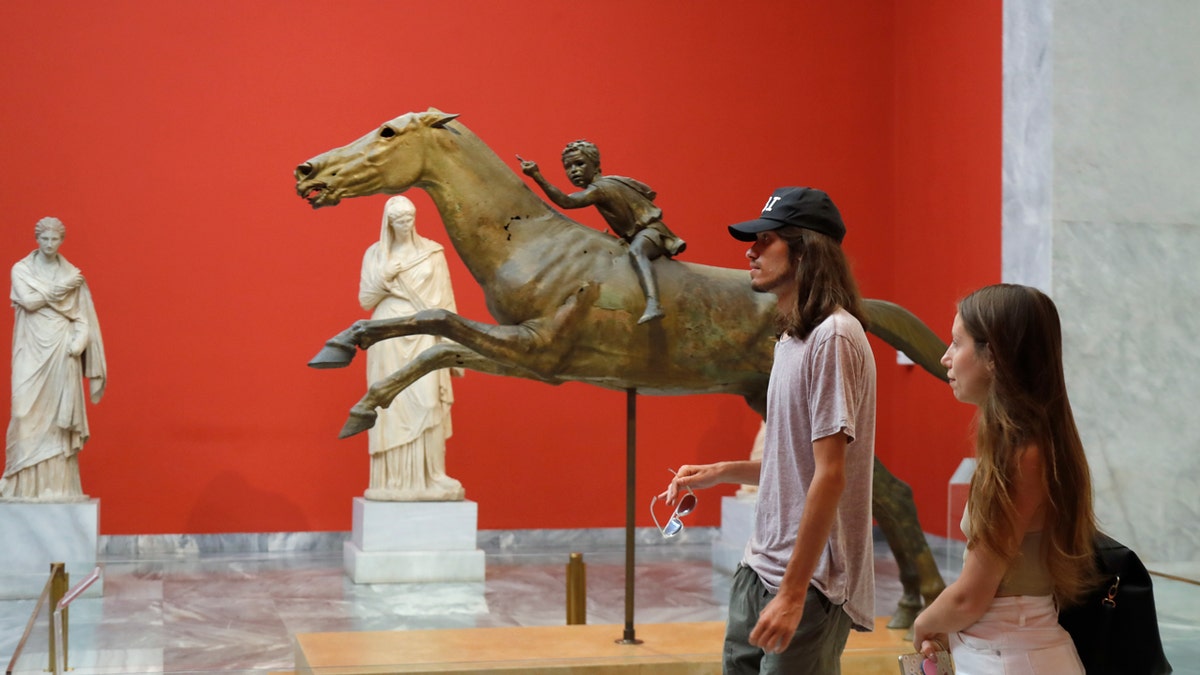All about National Archaeological Museum in Athens, one of the world’s most prominent museums of its kind

The National Archaeological Museum in Athens, Greece, houses significant artifacts dating back thousands of years. The museum includes five main permanent collections, as well as temporary ones, for guests to explore during their visit.
The museum was founded in 1829, originally headquartered in Aegina, the first capital of Greece, before being transferred to Athens in 1834, according to the National Archaeological Museum’s website.
Antiques were originally held in different buildings and monuments, before Eleni Tositsa donated land and the Bernardakis family sponsored the construction of the original building in 1866, which was designed by Ludwig Lange and saw modifications under Ernst Ziller, per the source.
The National Archaeological Museum in Greece is full of unique ancient finds, including statues, figurines, ceramics and more. (ANGELOS TZORTZINIS/AFP via Getty Images I Marios Lolos/Xinhua via Getty Images I MARTIN BERTRAND/Hans Lucas/AFP via Getty Images I Oscar Cañas/Europa Press via Getty Images)
ARCHAEOLOGISTS UNEARTH UNEXPECTED FIND INSIDE A TOMB LIKELY BELONGING TO A ROMAN GLADIATOR
In 1889, the museum first opened its doors for visitors, according to the National Archaeological Museum’s website.
From 1932 to 1939, the National Archaeological Museum saw further expansion with the designs of George Nomikos, according to the museum’s website.
Then was the start of World War II. During this time, all the artifacts were put in boxes and placed underground for safekeeping, the source reports, with repair work commencing after the conclusion of the war.
The National Archaeological Museum includes five main permanent collections; “Prehistoric Antiquities,” “Sculpture Collection,” “Vase and Minerals Collection,” “Metallurgical Works Collection” and “Egyptian and Eastern Antiquities.”

The National Archaeological Museum is located in Athens, Greece. (Panayotis Tzamaros/NurPhoto via Getty Images)
THE 4,000 ITEMS IN THE STAFFORDSHIRE HOARD MAKE IT THE LARGEST COLLECTION IN HISTORY OF ITS KIND
Each of the collections is unique in the artifacts included and brings pieces of the past into the present.
“Prehistoric Antiquities” includes work from the Neolithic period and the Bronze Age, from mainland Greece, the Aegean Islands and Troy, according to the museum’s website. Notable pieces part of this collection include the royal tombs of Mycenae, Cycladic marble figurines as well as wall paintings of Thera, per the source.
The “Sculpture Collection” is full of intricate sculptures dating from the 7th century B.C. up until the 5th century A.D., according to the National Archaeological Museum’s website.
The sculptures part of this collection include ones that have come from sanctuaries, necropolises as well as public buildings in Attica, Eastern Sterea Ellada, the Peloponnese and the Aegean Islands, according to the source.
Additionally, there are pieces of sculpted art as part of this collection that have come from Thessaly, Western Greece, Macedonia, Thrace and Cyprus, the website notes.

The National Archaeological Museum in Greece contains five primary and permanent exhibits. (National Archaeological Museum) (Photo by DeAgostini/Getty Images)
CLICK HERE TO GET THE FOX NEWS APP
The “Vase and Minerals Collection” includes Greek ceramics from the 11th century B.C. up through the Roman Era, according to the National Archaeological Museum.
Bronze works, heavily from excavations of the 19th and early 20th century make up the “Metallurgical Works Collection,” according to the museum’s website.
As for “Egyptian and Eastern Antiquities,” many pieces included have been thanks to donations from various donors, including Ioannis Dimitriou and Alexandros Rostovich.
More donations were from the Greek Archaeological Society in 1894 as well as the government of Egypt in 1893.









